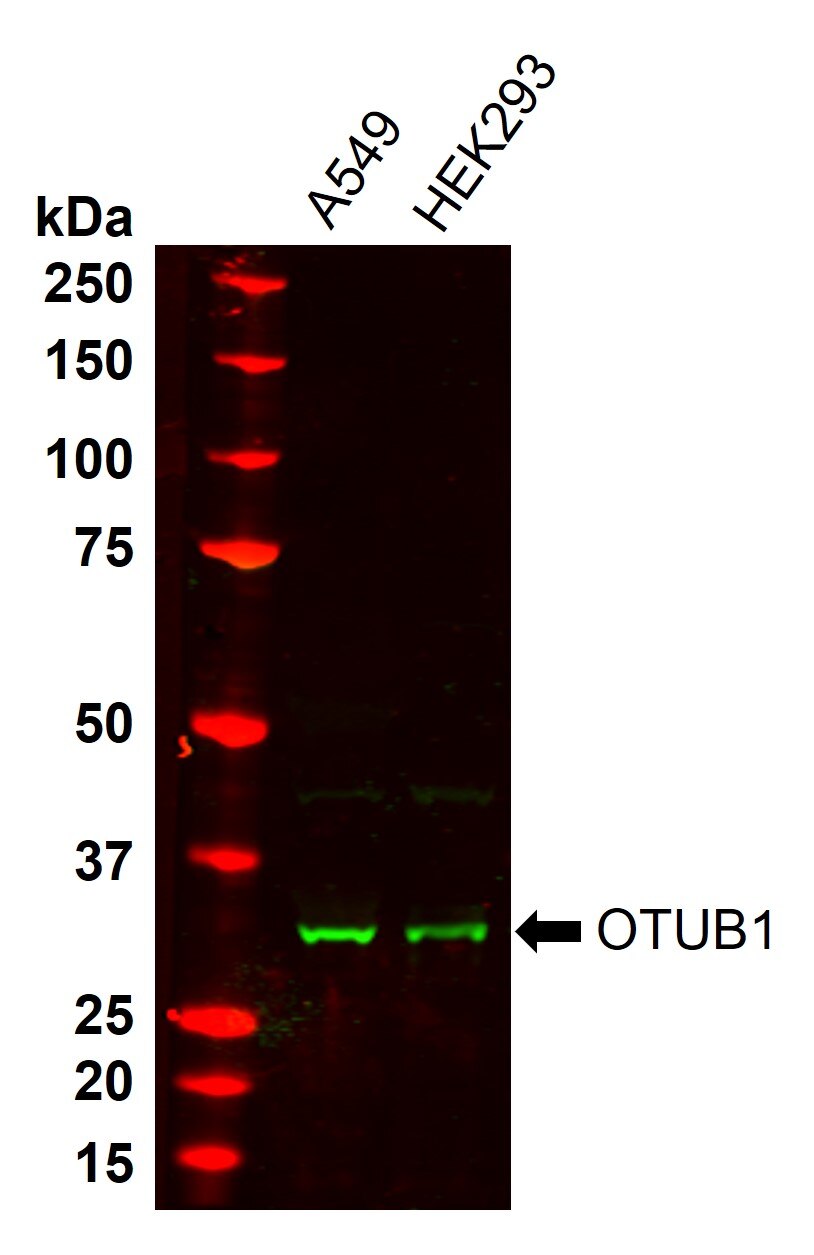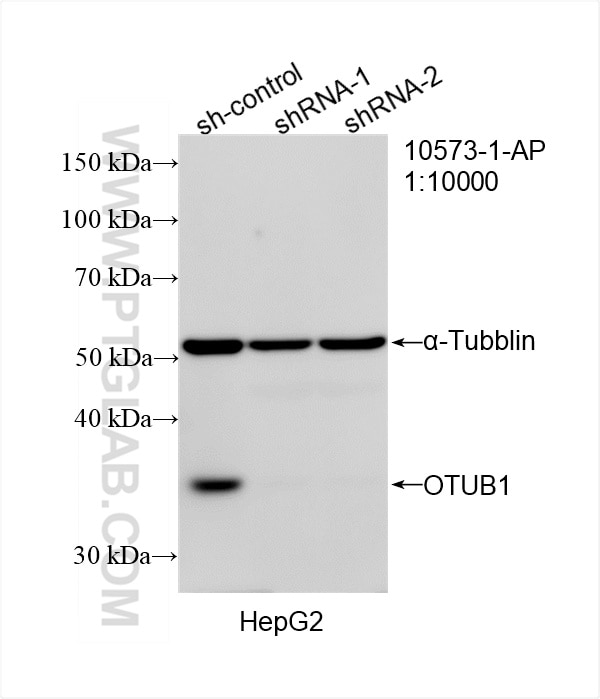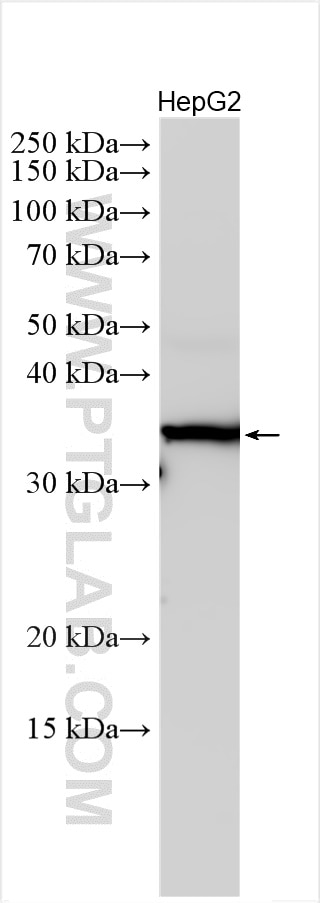- Phare
- Validé par KD/KO
Anticorps Polyclonal de lapin anti-OTUB1
OTUB1 Polyclonal Antibody for WB, IF/ICC, ELISA
Hôte / Isotype
Lapin / IgG
Réactivité testée
Humain, rat, souris
Applications
WB, IF/ICC, IP, CoIP, RIP, ELISA
Conjugaison
Non conjugué
N° de cat : 10573-1-AP
Synonymes
Galerie de données de validation
Applications testées
| Résultats positifs en WB | cellules MCF-7, cellules HepG2, tissu cérébral de rat, tissu cérébral de souris, tissu de cervelet de souris |
| Résultats positifs en IF/ICC | cellules U2OS, |
Dilution recommandée
| Application | Dilution |
|---|---|
| Western Blot (WB) | WB : 1:500-1:3000 |
| Immunofluorescence (IF)/ICC | IF/ICC : 1:200-1:800 |
| It is recommended that this reagent should be titrated in each testing system to obtain optimal results. | |
| Sample-dependent, check data in validation data gallery | |
Applications publiées
| WB | See 4 publications below |
| IF | See 2 publications below |
| IP | See 1 publications below |
| CoIP | See 1 publications below |
| RIP | See 1 publications below |
Informations sur le produit
10573-1-AP cible OTUB1 dans les applications de WB, IF/ICC, IP, CoIP, RIP, ELISA et montre une réactivité avec des échantillons Humain, rat, souris
| Réactivité | Humain, rat, souris |
| Réactivité citée | Humain, souris |
| Hôte / Isotype | Lapin / IgG |
| Clonalité | Polyclonal |
| Type | Anticorps |
| Immunogène | OTUB1 Protéine recombinante Ag0845 |
| Nom complet | OTU domain, ubiquitin aldehyde binding 1 |
| Masse moléculaire calculée | 31 kDa and 35 kDa |
| Poids moléculaire observé | 31-35 kDa |
| Numéro d’acquisition GenBank | BC007519 |
| Symbole du gène | OTUB1 |
| Identification du gène (NCBI) | 55611 |
| Conjugaison | Non conjugué |
| Forme | Liquide |
| Méthode de purification | Purification par affinité contre l'antigène |
| Tampon de stockage | PBS with 0.02% sodium azide and 50% glycerol |
| Conditions de stockage | Stocker à -20°C. Stable pendant un an après l'expédition. L'aliquotage n'est pas nécessaire pour le stockage à -20oC Les 20ul contiennent 0,1% de BSA. |
Informations générales
OTUB1 belongs to the ovarian tumor domain protease (OTU) subfamily of deubiquitinases, which could block ubiquitination leading to protein stability. OTUB1 mainly prefers k-48 and k-63 ubiquitin chains type, especially in k-48 ubiquitin chain. OTUB1 performs its deubiquitinating function via two distinct manners: the canonical and non-canonical manner. OTUB1 is involved in many critical immune response processes, containing CD8 T cell activation, PD-L1 related immune evasion, and several infectious diseases. OTUB1 plays an important role in the occurrence, proliferation, invasion, and progression of various cancers, such as bladder cancer, breast cancer, prostate cancer, and colorectal cancer (PMID: 34875341, 35296795). OTUB1 has 2 isoforms with molecular weights of 31 and 35 kDa, respectively. With phospho or ubiquitin modification or reaction, the MW of OTUB1 will be increased.
Protocole
| Product Specific Protocols | |
|---|---|
| WB protocol for OTUB1 antibody 10573-1-AP | Download protocol |
| IF protocol for OTUB1 antibody 10573-1-AP | Download protocol |
| Standard Protocols | |
|---|---|
| Click here to view our Standard Protocols |
Publications
| Species | Application | Title |
|---|---|---|
Adv Sci (Weinh) Primary Cilia Formation Mediated by Hsa_Circ_0005185/OTUB1/RAB8A Complex Inhibits Prostate Cancer Progression by Suppressing Hedgehog Signaling Pathway | ||
Biochem Pharmacol OTUB1 enhances fatty acid oxidation in APAP-induced liver injury by mediating ACSL5 deubiquitination | ||
ACS Pharmacol Transl Sci Bruceine B Displays Potent Antimyeloma Activity by Inducing the Degradation of the Transcription Factor c-Maf | ||
Exp Cell Res OTUB1 mediates PARP1 deubiquitination to alleviate NAFLD by regulating HMGB1 | ||
Sci Rep CircSCD1 inhibits ferroptosis in breast Cancer through stabilizing SCD1 protein via deubiquitinase OTUB1 |
Avis
The reviews below have been submitted by verified Proteintech customers who received an incentive for providing their feedback.
FH Angie (Verified Customer) (04-09-2024) | The antibody detected a band between 25 and 37 kD at dilution of 1:3000 incubated at room temperature for 2 hours. This is followed by secondary antibody donkey-anti-rabbit (Alexa Fluor 800) used at 1:20000 dilution and incubated for 1 hour at room temperature.
 |





